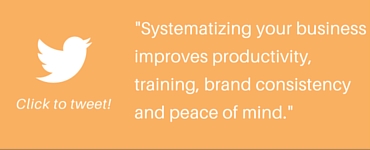How Creating Systems & Workflows for Your Wedding Business Can Set You Free
One of the most common sources of frustration I hear from wedding professionals is that they feel “stuck” running the day-to-day operations of their businesses. They know they need to focus on being strategic leaders of their business in order to become more profitable and efficient, but that’s easier said than done. Rather than functioning as the CEO of their company, they’re the salesperson, the craftsman, the delivery driver and so much more.
Of course, I can relate. While my primary business is now run by an incredible team, it wasn’t always that way – I spent years toiling over customer service, sales and marketing, payroll, operations and more, and ran myself ragged. When you’re scraping by as a startup, or when resources are scarce, you have no choice but to put your head down and just do the work.
Still, that can’t be a long-term strategy for success.
This isn’t a new concept, but it’s an important one. In one of my all-time favorite business books, The E-Myth Revisited, author Michael E. Gerber talks about why business owners need to focus their efforts on working on their business, not in it. Only then can you take your business from an exhausting, yet not particularly profitable, one-man (or one-woman) operation to a thriving, scalable success.
Before we get into how you can start to systematize, let’s talk about what you’ll get out of the process.
Benefits of Systematizing Your Wedding Business
When you create documented, standardized, streamlined systems, you’ll experience the following:
- Boosted productivity – by following your systems, you’ll be able to get more done, with more focus, in less time
- More effective training and delegation – by laying out a set of systems and workflows, you’ll be able to more easily train your team (current or future) and you’ll feel more comfortable delegating tasks to them, freeing your own time for higher-level work or personal pursuits
- Improved brand consistency – when you have identified a set of systems that govern your sales, customer service, and product/service delivery, you’ll know that every client receives the same experience with your company
- Greater peace of mind – you’ll know that your business can still function if you are forced to step back to deal with a personal emergency, or if you receive a professional opportunity that pulls you away from the day-to-day operations of your business
- A benchmark by which to assess and modify your systems for even greater efficiency – once you have actually created systems, you can find ways to constantly improve them, rather than “flying blind” and hoping for the best
Are you sold yet on why systematizing your wedding business is worth the effort? You should be!
Later this week, I’ll be sharing how to create and formalize your company’s systems – your standard operating procedures – but, before you can do that, you need to take stock of what exactly your company does.
What Do You Need to Be Able to Systematize?
In order to create systems and workflows that actually, you know, work, you need to have a clear picture of what you (and any team members you may have) actually do on a daily, weekly, monthly and quarterly basis. Kyle and I go into some detail on this in our e-book Sailing Through Crisis, but in a nutshell, here’s what you need to do:
- Start a list, using any format that’s comfortable for you (for example, pen and paper or a document in Evernote or your note-taking app of choice). Keep it with you at all times while you’re working and write down literally every function you perform in your job, no matter how small or mundane. This might include: responding to emails and answering the phone; writing proposals and contracts for clients; posting to social media; soliciting client reviews; creating your products; scheduling staff members; paying bills and calculating payroll; and (almost certainly) much more. If it takes one minute or more of your time, it should go on the list.
- Creating this list should take at least a full week, maybe more if things are a little slow. The point is to get as complete a record as possible of what occupies your time. Then, you can take that list and add in the things you do less frequently, but are still part of your responsibilities: things like ordering supplies, updating your insurance/licenses/certifications, designing marketing collaterals, setting your marketing and operating budgets, preparing your taxes, planning your team’s holiday celebration, etc.
- If you currently have other people working for you, you’ll need to perform a similar process for their tasks and responsibilities, too. You can have them keep a list like you’ve done, or – especially if you know you want things done differently going forward – you can put your thinking cap on and brainstorm what your “ideal” team would be doing on a regular basis. (Kyle will be writing about this on Wednesday, so be sure to check back for that post!)
- Finally, wrap up this part of your preparation by doing a good old-fashioned brain dump. Ask yourself, what are the areas of your business that you know could be executed in a more organized, effective fashion? What are some training topics you know you need to address with your team? (And, if you don’t yet have a team, what do you imagine you’d need to train someone new when you do hire them?) What parts of your business and brand would you like to see carried out the same way, every time, in a perfectly consistent fashion?
Documenting Your Systems
Once you’ve completed all the items above, you can start to actually create your new systems. Remember that the entire point of systematizing is to specify, step-by-step, what actually needs to be done, and by what process. This kind of precision is what enables you to set clear standards for each part of your business, to delegate responsibilities to others, and to feel that reassurance that everything is being completed in an effective, brand-consistent fashion.
As with your task inventory, this part of the process will require an investment of time – it definitely won’t happen overnight! Over the next several weeks, as you’re completing your responsibilities, you’ll want to begin to document actually how you’re completing them. Imagine that you’re tasked with training someone new (because eventually, you will be), and make notes of exactly what needs to be done to check an item off your to-do list.
Here are just a few examples of tasks/projects for which you might want to document the steps to completion:
- Your client sales process, including the initial inquiry, sales consultation, proposal/contract, payment, etc.
- Your client service process, including whatever goes into executing their event, such as design/planning meetings, communications, paperwork, etc.
- Logging into and using any software or computer systems for your company, such as your CRM program, scheduling program, time tracking program, design program, etc.
- Posting updates to your website, blog, and/or social media
- Scheduling staff for your events
- Bookkeeping/payroll calculation
- Producing any deliverables offered by your company
As I mentioned, this is obviously going to be time-consuming, but it will be well worth the effort in terms of making your company more efficient and more scalable in the future.
Note: writing down the steps (by hand or in an electronic note) is an obvious method, but another option is to make a video. Software programs like Camtasia allow you to easily record what you’re doing on your computer screen (ideal if you’re explaining the steps for posting to your website or blog, or how to use your company’s software). You can even record a video on your phone, enabling you to stroll around your office/studio/warehouse and explain what you’re doing. It’s similar to when you dictate audio notes while you’re driving – the idea is just to use a simple method to create a record of your tasks and how to execute them, and sometimes video is by far the simplest.
Again, Kyle will be posting Wednesday on creating job descriptions for your team (including future new hires), and on Friday I’ll help you put everything together into a set of standard operating procedures. Don’t miss these valuable posts! In the meantime, if you’re eager to get started with some one-on-one help, I offer a two-session coaching package specifically on this topic. Also, keep an eye on WeddingIQ’s resources page, as we’ll soon be rolling out a comprehensive guide to creating your company manual and SOPs! Can’t wait for you to see!














